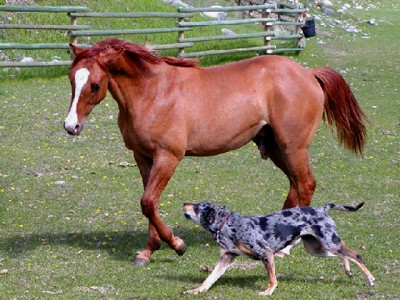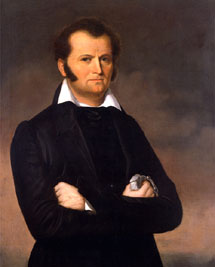
HISTORY I have heard and read various versions of how, historically the Catahoula Leopard dog came to be. Fact or Legend, this is truly a strange and unique breed of dog. I believe the mystery surrounding the Catahoula adds to the mystique. There are a few books and websites that offer their hypothesis on the origins of the Catahoula and some pose very convincing, well researched, and well thought out arguments. I invite you to explore Catahoula History and let me know what you learn. In the meantime here is a summery of what I have come across……..

Tales handed down from one generation to another link the Catahoula to the Natchez Indian tribes, which lived in Louisiana before Hernandez De Soto set foot there in 1542. Another theory connects the origins of the dogs with the Spanish. The scribes who came with De Soto left no description of the “war dogs” they brought along on the gold hunt, other than mentioning that the dogs were vicious, man-hating. The chroniclers did write that the Spanish commander, on several occasions unleashed his dogs and permitted them to tear live animals and/or Indians into shreds, to intimidate the horror stricken Indians. De Soto had a well-earned reputation for ruthlessness, so it comes as no surprise to learn that when he departed, he left many wounded war dogs behind to suffer their fates. Could it be the very Indians these beasts had been used against, took them in as prized spoils of war? Maybe some of these war dogs interbred with the common Red Wolf, and their progeny was the foundation of the Catahoulas. Short haired, mottled colored and of medium to large size, these dogs possessed natural ability to work livestock and hunt game by winding instead of trailing. They also provided companionship and aggressive protection for the Indians, and later the early settlers to the area.

In 1682, Rene’ Robert Cavelier, Sieur de La Salle and Henri de Tonti, descended the Mississippi river with their party of French and Native Americans. It is said that they became intrigued with strange-looking dogs with haunting light eyes. The French found that the wolf-like dogs had the ability to successfully hunt game in the swamp because of several characteristics including a keen sense of smell and webbed feet. The dogs could also easily retrieve cattle, which had wandered into marshy areas. The French had brought with them their own dogs, known today as the Beauceron. The Beauceron dates back to the mid 1500’s and was originally used to hunt wild boar. It is believed that in an attempt to create an even better hunter, protector, companion, and herder, the French crossed the Beauceron with these wolf-like dogs. Could the Catahoula Leopard Dog be a descendant of that crossing? It is thought that the Indians gave the dogs the name Catahoula – which means, “clear water” – due to the breeds trademark translucent, eerie blue eyes. The dogs were also found in great numbers around the Catahoula Lakes region of Louisiana.

One hundred and twenty years later, in 1802, Rezin Bowie and his famed brother Jim, owned a pair of “leopard dogs.” Jim Bowie who found his home in Natchez Mississippi, not far from the lake found faithful companionship with a Catahoula named “Blue” It is rumored that Jim’s blue eyed dog was an incredible hunter and unmatched in the pit. Perhaps these strange dogs lay at the feet of Rezin, who owned some land known as Utility Plantation just a few miles west of Jonesville, Louisiana. Rezin designed the famous Bowie knife, which Jim wielded so adeptly at the Alamo. The Catahoula has come a long way from the crossbred product of De Soto’s Mastiff-like war dogs and the once common Red Wolf, which is the most accepted theory as to how the breed evolved. There is a definite strangeness encompassing this canine. Its origin will remain mysterious. Articles of the Catahoula swamp dog appeared when reporters recording one Teddy Roosevelt’s hunting trips in the marshes of east Texas brought attention to this unique dog. The Catahoula almost faced extinction at one time due to indiscriminate crossbreeding. Thankfully, dedicated breeders, ” like the great governor of Louisiana Earl K. Long, was partly responsible for preserving the breed when they became a favorite of his and he collected and bred the best from around the state. Louisiana Governor Huey Long was also dedicated to preserving and protecting the spotted dogs. In fact, for some time in Louisiana the dogs went by the name of… “Huey Long Stock Dogs”. Catahoulas were also seen in the films, “Savage Sam” and “Home From the Hills”, and in the 1936 John Wayne film “The Lonely Trail”. And I am told, movie and television star David Carradine became a Louisiana Catahoula Certified Breeder when he purchased puppies while on location in Louisiana filming the mini series “North & South”. Tom Stodghill (founder of the Animal research foundation) found exception with the breed importing them to southeast Texas and began to register them as early as 1951. Kline Rushing and his Daughter Betty Ann Eaves founders of the National Association of Louisiana Catahoulas kept detailed records on there breeding and eventually obtained pedigrees for their dogs. After her father passed away in June 1977, Betty Ann formed National Association of Louisiana Catahoulas (NALC) in October 10, 1977. Through her efforts on July 9, 1979, Governor Edwin Edwards signed a bill that made the Louisiana Catahoula Leopard Dog , the Louisiana State dog. The NALC has played a major role and is greatly responsible for the preservation of the Louisiana Catahoula Leopard Dog we know today.
So to what does all boil down?

A Catahoula is 50+ pounds of muscle, hair, teeth and claws. Tautly muscled, rugged and athletic, this is a true all purpose breed. They come in blue merle, red merle, solid black, solid red, black and tan, red and tan, yellow and a variety of many other colors and combinations. Their eyes come in blue, brown, gold, green, marbled, two different color eyes and any other combination imaginable. The Catahoula Leopard Dog was developed in the swamps of Louisiana and were it was used primarily for hunting, but also for guarding, herding and chasing down wild hogs. The only dogs that were kept were the best hunters and working dogs. Breeders practiced strict culling to ensure only the best were bred.

Today they are still intense stock workers, guard and hunting dogs but are also used for service work, search and rescue, agility, companions and family pets. They are highly adaptable to nearly any environment and can be found all over the world. The Catahoula personality is something to behold. They are affectionate, faithful and loyal. They are completely devoted and protective of their families and above all their children. Any person who has Catahoulas will tell you that you do not own a Catahoula, he owns you. He is your self appointed guardian whether you like it or not. Your children are his children and he takes this very seriously. A Catahoula also tends to be a clown and will join any activity whatever it may be. These dogs have more personality that some people.

These dogs have an independent take-charge nature that can be rambunctious, restless and destructive. They require an experienced or at least educated dog owner who can provide at least hour of physical exercise daily, training and above all patience.
